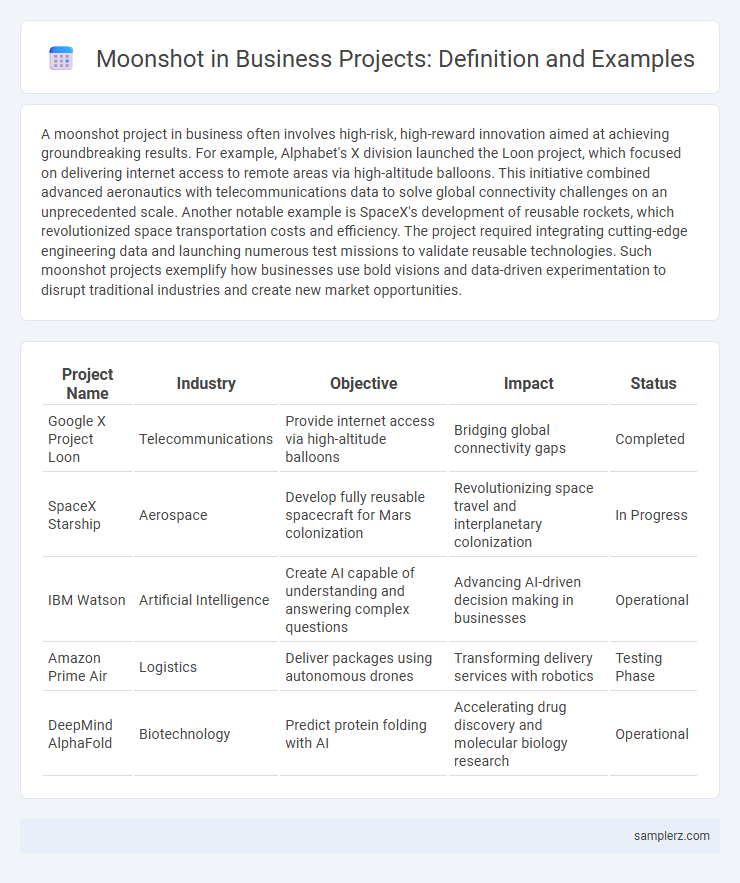A moonshot project in business often involves high-risk, high-reward innovation aimed at achieving groundbreaking results. For example, Alphabet's X division launched the Loon project, which focused on delivering internet access to remote areas via high-altitude balloons. This initiative combined advanced aeronautics with telecommunications data to solve global connectivity challenges on an unprecedented scale. Another notable example is SpaceX's development of reusable rockets, which revolutionized space transportation costs and efficiency. The project required integrating cutting-edge engineering data and launching numerous test missions to validate reusable technologies. Such moonshot projects exemplify how businesses use bold visions and data-driven experimentation to disrupt traditional industries and create new market opportunities.
Table of Comparison
| Project Name | Industry | Objective | Impact | Status |
|---|---|---|---|---|
| Google X Project Loon | Telecommunications | Provide internet access via high-altitude balloons | Bridging global connectivity gaps | Completed |
| SpaceX Starship | Aerospace | Develop fully reusable spacecraft for Mars colonization | Revolutionizing space travel and interplanetary colonization | In Progress |
| IBM Watson | Artificial Intelligence | Create AI capable of understanding and answering complex questions | Advancing AI-driven decision making in businesses | Operational |
| Amazon Prime Air | Logistics | Deliver packages using autonomous drones | Transforming delivery services with robotics | Testing Phase |
| DeepMind AlphaFold | Biotechnology | Predict protein folding with AI | Accelerating drug discovery and molecular biology research | Operational |
Defining Moonshots in Business Projects
Moonshots in business projects target breakthrough innovations with the potential to redefine entire industries, such as Google's development of Waymo for autonomous vehicles. These high-risk, high-reward initiatives focus on solving complex problems by leveraging advanced technologies like artificial intelligence and quantum computing. Defining a moonshot involves setting ambitious, measurable goals that challenge conventional limitations and drive exponential growth.
Characteristics of a Moonshot Initiative
A moonshot initiative in business embodies ambitious goals that challenge conventional limitations, typically aiming for a tenfold improvement rather than incremental gains. Such projects require breakthrough technologies or innovative business models with high uncertainty and substantial risk, often transforming entire industries or creating new markets. Key characteristics include bold vision, resource-intensive investment, long-term commitment, and a culture that encourages experimentation and tolerates failure.
Notable Historical Moonshot Examples
Notable historical moonshot projects include NASA's Apollo program, which successfully landed humans on the Moon in 1969, revolutionizing space exploration and technology. Another example is Google's development of self-driving car technology under its Waymo project, aiming to eliminate traffic accidents and transform transportation. These ambitious initiatives demonstrate how visionary goals combined with cutting-edge innovation can lead to groundbreaking advancements across industries.
Modern Corporate Moonshot Projects
Modern corporate moonshot projects include initiatives like Google's Project Loon, which aims to provide global internet access through high-altitude balloons, and Tesla's pursuit of fully autonomous electric vehicles to revolutionize transportation. Amazon's development of drone delivery systems seeks to enhance logistics efficiency and reduce delivery times dramatically. These projects exemplify ambitious goals that leverage cutting-edge technology to solve complex global challenges and disrupt traditional industries.
Key Elements of a Successful Moonshot
A successful moonshot project hinges on visionary goals that challenge industry norms and drive breakthrough innovation, often leveraging emerging technologies such as artificial intelligence or quantum computing. It requires a multidisciplinary team culture fostering risk tolerance, creative problem-solving, and agile iteration to navigate uncertainty and pivot strategies effectively. Strategic resource allocation alongside strong leadership commitment ensures sustained momentum and measurable impact aligned with transformative business objectives.
Case Study: Google X and Innovation
Google X, known for its breakthrough projects, exemplifies a moonshot by tackling ambitious challenges such as self-driving cars and Project Loon's internet balloons. This innovation lab leverages advanced technologies like AI, robotics, and machine learning to drive radical solutions with potential to transform industries globally. Its methodology involves rapid prototyping, extensive testing, and a tolerance for failure to accelerate progress toward disruptive breakthroughs.
Risks and Rewards of Pursuing Moonshots
Pursuing moonshot projects involves high risks such as significant financial investment, uncertain market acceptance, and potential failure to meet technological milestones. However, the rewards include breakthrough innovations that can disrupt industries, create new markets, and yield substantial competitive advantages. Companies like SpaceX and Google demonstrate how moonshots can drive exponential growth despite initial setbacks and challenges.
How to Foster a Moonshot Mindset in Teams
Encouraging radical innovation requires creating a culture where risk-taking and ambitious goals are celebrated, supported by leadership that invests in breakthrough research and provides resources for experimental projects. Teams should be empowered to challenge conventional thinking by setting audacious targets aligned with transformative business opportunities, such as launching entirely new product categories or leveraging emerging technologies like AI or quantum computing. Embedding iterative learning processes and cross-functional collaboration accelerates idea validation, fostering an environment where moonshot initiatives can evolve from visionary concepts to market-disrupting realities.
Lessons Learned from Failed Moonshot Projects
Failed moonshot projects, such as Google's Glass and Microsoft's Zune, highlight the importance of market readiness and user-centric design in pioneering innovations. These ventures often underestimated consumer adoption rates and overestimated technological maturity, leading to costly setbacks and strategic pivots. Lessons learned emphasize the need for agile development, realistic goal-setting, and continuous market feedback integration to increase the likelihood of success in ambitious business projects.
Future Trends in Moonshot Project Development
Moonshot projects in business increasingly emphasize breakthrough technologies like artificial intelligence, quantum computing, and renewable energy to address global challenges. Companies are investing in predictive analytics and advanced simulations to anticipate future market demands and accelerate innovation cycles. The integration of cross-industry collaborations enhances scalability and impact, driving transformative solutions that redefine competitive landscapes.

example of moonshot in project Infographic
 samplerz.com
samplerz.com